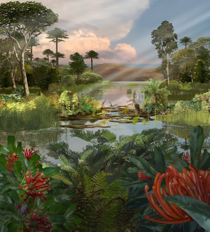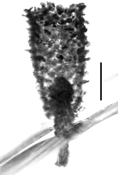By Skylar Block
A very tiny fungus makes for a large discovery!
Palaeoagaracites antiquus (palaeo meaning “old”, agaracites meaning “mushroom”, and antiquus also meaning “old”) (Poinar, 2007) was discovered in Burmese amber. The minute mushroom (cap being only 2.2 mm in diameter) (Poinar, 2007), is about 100 million years old. At this time in history (the Lower Cretaceous, Upper Albian stage) (Poinar, 2007), dinosaurs roamed the earth as well as other invertebrates that are familiar to us today including the ancestors of sharks and crocodiles. Evidence suggests fungi were around long before then (about 1,500 million years ago) (Brundrette, 2002) but this is the oldest discovered preserved mushroom which makes it a significant discovery.
P. antiquus‘ age is not the only significant property about it. Scientists discovered not one but two other organisms growing on the mushroom! Parasitization is the relationship between two organisms where one organism is benefitting from the other at the other’s expense. There hadn’t been any evidence of mycoparasitism (a parasite that attacks fungi) in early stages of life until the unearthing of P. antiquus (Poinar, 2007). Pesky Mycetophagites atrebora was attacking P. antiquus before they were both swallowed in amber and preserved through the ages. The vegetative growth part (mycelium) of M. atrebora was found covering the cap of P. antiquus and more mycelium growing in the host’s tissues (Poinar, 2007). Evidence that a toxic substance caused cell lysis (bursting of cells) of the host suggests that M. atrebora was a necrotroph (an organism that parasitizes and kills it’s host) (Poinar, 2007). But the joke was on M. atrebora because it was getting eaten, too! Third and last to the party was Entropezites patricii. E. patricii was also most likely a necrotroph as scientists found it’s mycelium invading and destroying the mycelium of M. atrebroa. (Poinar, 2007).

Cretaceous landscape
Cretaceous landscape
http://australianmuseum.net.au/image/Late-Cretaceous-Landscape/
Few other fungi have been preserved. This is due to the fact that fungi are soft- bodied organisms which make them susceptible to decomposition, especially over extended periods of time. Other fungi that made it through preservation include Aureofungus yaniguaensis (http://en.wikipedia.org/wiki/Aureofungus), Coprinites dominicana (http://en.wikipedia.org/wiki/Coprinites), Protomycena electra (http://en.wikipedia.org/wiki/Protomycena), and Archaeomarasmius leggetti (http://en.wikipedia.org/wiki/Archaeomarasmius). Hot off the press, two “bird’s nest fungi” have just been unearthed in the Baltic area and the Dominican Republic. The specimens are extremely well preserved. The specimen hailing from the Baltic is an estimated 40 and 50 million years old and the specimen from the Dominican Republic is about 20-15 million years old (Poinar, 2014).
Scientists enjoy classifying organisms that they find. It makes it easier to see how organisms are related to each other and helps to keep everyone organized. The need to classify and name organisms is difficult for scientists who study fungi (mycologists) in particular because little is known about even modern-day mushrooms. Imagine the problems they run into when naming fungi that haven’t been around for 100 million years! Luckily, fungi have distinct morphological (the structure and forms of an organism we can see) features that can be helpful during the identification process. This is what has helped to identify P. antiquus. Unfortunately, because mushrooms don’t like to be preserved, we often find very partial specimens in amber (Girard, 2010) which makes seeing these morphological features difficult to see. Normally, scientists could fall back on DNA analysis to classify an organism but what happens to DNA trapped in amber makes that nearly impossible. This is because very little DNA is preserved in amber (Girard, 2010). Some scientists argue that because we are unable to reproduce ancient DNA, because there is so little of it to begin with, and because of possible contamination issues, identifying DNA preserved in amber is impossible (Girard, 2010).
Although fungi preserved in amber is a rare treasure, we can be assured that they will keep popping up as we search. They may even hold surprises such as a three-tiered parasitization. Each discovery will help to better our understanding of ancient fungi and thus, present day fungi as well. Even if we are unable to classify the organisms with 100% confidence, it does not mean their discovery is insignificant in the slightest!
Works Cited
1. Albian. (2013, 30). In Wikipedia, the Free Encyclopedia. Retrieved from http://en.wikipedia.org/w/index.php?title=Albian&oldid=588287105
2. Brundrett, M. C. (2002). Coevolution of roots and mycorrhizas of land plants. New Phytologist, 154(2), 275–304. doi:10.1046/j.1469-8137.2002.00397.x
3. Evolution of fungi. (2014, 20). In Wikipedia, the Free Encyclopedia. Retrieved from http://en.wikipedia.org/w/index.php?title=Evolution_of_fungi&oldid=591554364
4. Girard, V., & Adl, S. M. (2011). Amber microfossils: On the validity of species concept. Comptes Rendus Palevol, 10(2–3), 189–200. doi:10.1016/j.crpv.2010.11.002
5. Poinar Jr., G. (2014). Bird’s nest fungi (Nidulariales: Nidulariaceae) in Baltic and Dominican amber. Fungal Biology. doi:10.1016/j.funbio.2014.01.004
6. Poinar Jr., G. O., & Buckley, R. (2007). Evidence of mycoparasitism and hypermycoparasitism in Early Cretaceous amber. Mycological Research, 111(4), 503–506. doi:10.1016/j.mycres.2007.02.004


